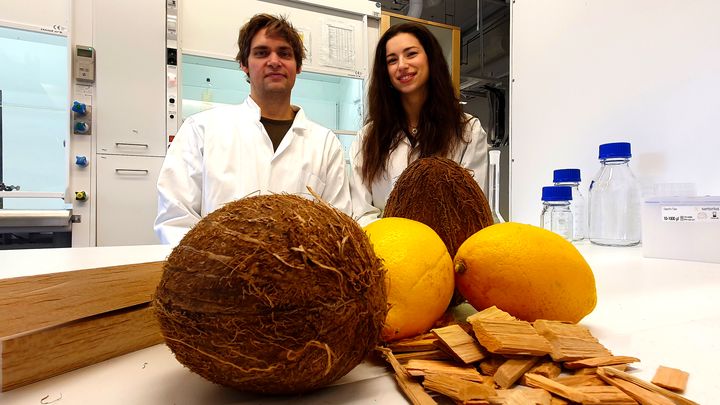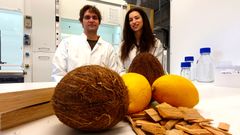Coconuts and lemons enable a thermal wood for indoor heating and cooling

Researchers reported the development in the scientific journal, Small. Peter Olsén, researcher in the Department of Biocomposites at KTH, says the material is capable of storing both heat and cold. If used in housing construction, the researchers say that 100 kilos of the material can save about 2.5 kWh per day in heating or cooling—given an ambient temperature of 24C.
KTH researcher Céline Montanari says that besides sunlight, any heat source can charge the battery. “The key is that the temperature fluctuates around the transition temperature, 24C, which can of course be tailored depending on the application and location,” she says.
The process starts with removing lignin from wood, which creates open pores in the wood cells walls, and removes color. Later the wood structure is filled with a citrus-based molecule—limonene acrylate—and coconut based molecule. Limonene acrylate transforms into a bio-based polymer when heated, restoring the wood’s strength and allowing light to permeate. When this happens the coconut molecule are trapped within the material, enabling the storage and release of energy.
“The elegance is that the coconut molecules can transition from a solid-to-liquid which absorbs energy; or from liquid-to-solid which releases energy, in much the same way that water freezes and melts,” Montanari says. But in the transparent wood, that transition happens at a more comfortable 24C
“Through this transition, we can heat or cool our surroundings, whichever is needed,” Olsén says
Olsén says that potential uses include exterior and interior building material for both transparency and energy saving – in exteriors and interiors. The first application of the product would be for interior spaces to regulate temperatures around the 24C mark to cool and to heat. More study is needed to develop it for exterior use.
And it’s not just for homes or buildings. “Why not as a future material in greenhouses?” he says. “When the sun shines, the wood becomes transparent and stores more energy, while at night it becomes cloudy and releases the heat stored during the day. That would help reduce energy consumption for heating and at the same time provide improved growth.”
"Sustainable Thermal Energy Batteries from Fully Bio-Based Transparent Wood", Small, DOI: https://doi.org/10.1002/smll.202301262
Keywords
Images

About KTH Royal Institute of Technology
About KTH Royal Institute of Technology
Since its founding in 1827, KTH Royal Institute of Technology in Stockholm has become one of Europe’s leading technical and engineering universities, as well as a key center of intellectual talent and innovation.
KTH works with industry and society in the pursuit of sustainable solutions to some of humanity’s greatest challenges: climate change, future energy supply, urbanization and quality of life for the rapidly-growing elderly population. We are addressing these with world leading, high-impact research and education in natural sciences and all branches of engineering, as well as in architecture, industrial management, urban planning, history and philosophy.
KTH is Sweden’s largest technical research and learning institution and home to students, researchers and faculty from around the world.
Subscribe to releases from KTH Royal Institute of Technology
Subscribe to all the latest releases from KTH Royal Institute of Technology by registering your e-mail address below. You can unsubscribe at any time.
Latest releases from KTH Royal Institute of Technology
AI helps decode horses' body language for better veterinary care9.4.2025 12:20:55 CEST | Press Release
Researchers are using AI to bridge the communication gap between horse and human. Combining 3D motion capture and machine learning, a new modeling system would equip veterinarians with a powerful visual tool for interpreting equine body language—the key to detecting physical and even behavioral problems.
New Swedish Initiative to Integrate Research and Healthcare4.4.2025 11:37:56 CEST | Press Release
A groundbreaking national initiative, Precision Omics Initiative Sweden (PROMISE), aims to connect research with healthcare and establish Sweden as a world leader in data-driven precision medicine.
For graphene production, a potential green alternative to mining graphite3.3.2025 14:14:40 CET | Press Release
Researchers in Sweden report a green alternative to reduce reliance on mining graphite, the raw source behind the "wonder material" graphene.
AI on aircraft can help prevent stalls and terrifying drops in altitude17.2.2025 15:58:14 CET | Press Release
Artificial intelligence could help prevent terrifying mid-air drops in altitude. In a new study, an international research team successfully tested a machine learning system for preventing trouble with turbulence.
Alternative to studded winter tires reduces airborne particles by 20 percent6.2.2025 14:41:07 CET | Press Release
On icy roads, studded winter tires can save lives – but they pulverize pavement and fill the air with dangerous, inhalable particles. A new Swedish study shows that both road wear and airborne particles could be reduced by as much as 20 percent if studs were made instead with an alternative hard metal.
In our pressroom you can read all our latest releases, find our press contacts, images, documents and other relevant information about us.
Visit our pressroom
